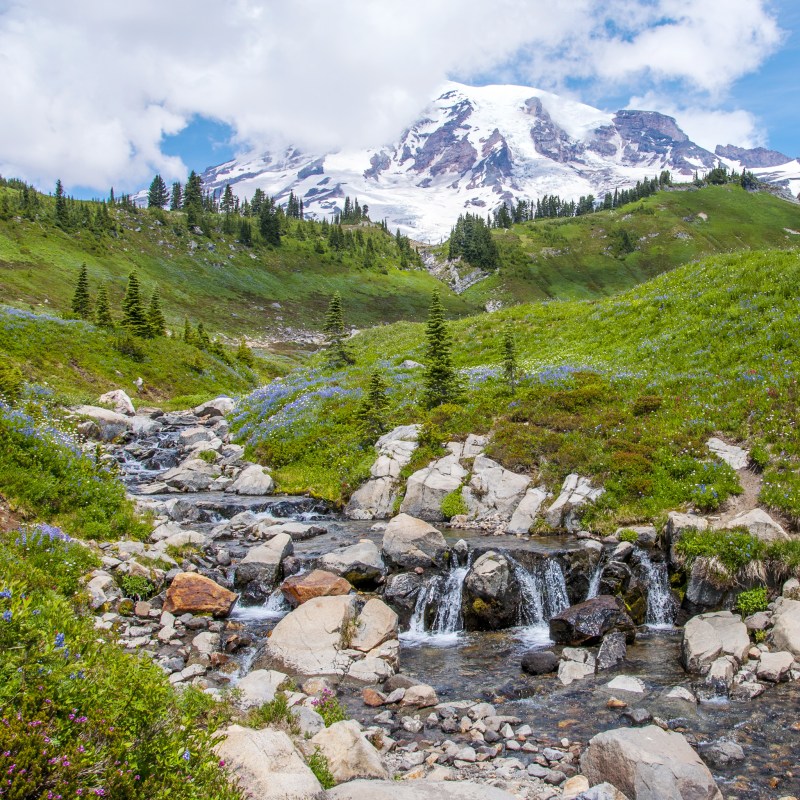
The stunning beauty of Mount Rainier National Park, with its old-growth forests, crystal-clear alpine lakes, cascading waterfalls, rushing rivers, and world-famous wildflower meadows is best experienced by hiking through it all. From short and accessible paved trails to the famous 93-mile-long Wonderland Trail and everything in between, you’ll find plenty of opportunities to hike here and experience the gorgeous scenery.
Videos by TravelAwaits
Hiking season in Mount Rainier is between May and September. However, the best time to enjoy the wildflower meadows at the higher elevations is from late July through August. The most famous trails in the park are in and around Paradise. This is where you’ll find the wildflower meadows the area got its name from, surrounded by groves of fir and hemlock, with gorgeous views of the glacier-filled mountain in the background.
But Paradise is not the only place to experience gorgeous scenery in the park. You’ll find similar wildflower-filled meadows in Sunrise, while at lower elevations the Longmire District and Ohanapecosh offer hiking opportunities through old-growth forests, meadows, and riversides.
The following trails are just a sample of my favorites in Mount Rainier National Park, the ones I return to and hike over and over, every time I visit the park. It’s the scenery, accessibility, and relatively low elevation gain that makes them my favorites.

Emese Fromm
1. Skyline Trail To Myrtle Falls
Paradise
The main trail in Paradise, the full Skyline Trail, at 5.5 miles and 1,700 feet in elevation gain, is strenuous. But you can follow it for shorter distances in either direction for dramatic views of the most famous and most photographed area of Mount Rainier National Park.
For an easy, one-mile round-trip trail showcasing gorgeous views of the surrounding wildflower meadows and Myrtle Falls, follow it counterclockwise. You’ll reach the spectacular 72-foot-tall Myrtle Falls, about a half-mile from the start. Here, a short spur trail leads to a dramatic view of the falls dropping into a gorge, a favorite spot for photographers. Before turning around, walk past the bridge for a quick stroll along the wildflower meadows.
The Skyline Trail starts behind the Jackson Visitor Center at Paradise.

2. Nisqually Vista Trail
Paradise
The paved and accessible Nisqually Vista Trail in Paradise showcases some of the most dramatic views of both Mount Rainier and the Nisqually Glacier — on a cloudless day. You’ll walk through dense pine-forests and a few open meadows. During wildflower season, you’ll see these meadows filled with pink and white mountain heather, magenta and scarlet paintbrush, purple lupines, and other subalpine wildflowers. Stop at the viewpoints to glimpse the Nisqually Glacier, though it might be shrouded in clouds. Sometimes, if you spend some time there, the clouds might part to reveal one of the major glaciers of Mount Rainier.
A 1.2-mile loop, the Nisqually Vista Trail starts at the end of the lower Visitor Center parking lot in Paradise, and it usually takes about 45 minutes to an hour to complete.

Emese Fromm
3. The Trail Of The Shadows
Longmire Historic District
To experience a combination of human and natural history, walk the Trail of the Shadows circling a meadow in the Longmire Historic District. Part of the trail is paved and accessible, with gorgeous views of Mount Rainier in the distance. Watch for wildlife in the meadow. More often than not, we’ve seen deer and even a newborn fawn in the open area. As it circles the meadow, the trail leads through a forest — watch your step around tree roots here. Then you’ll walk by a few hot-spring areas and a replica of an old homestead cabin of the Longmire family.
At 0.7 miles, the trail is short and flat, an easy stroll in the forest and around a meadow at the lower elevations of Longmire. You’ll find the trail across the street from the National Park Inn.

4. Grove Of The Patriarchs Trail
Ohanapecosh Area
The Grove of the Patriarchs Trail winds through to some of the oldest trees in the park, a few of them over 1,000 years old. The 1.5-mile trail, a combination of wide, flat, packed dirt and boardwalk crosses the Ohanapecosh River on a suspension bridge to take you through ancient towering Douglas fir and red cedar trees reaching heights up to 300 feet. A few areas by the river pass through spots with exposed tree-roots, but you’ll find most of the trail an easy stroll.
You’ll find the trailhead just west of the Stevens Canyon Entrance Station, off the main road. Being a popular trail, the parking lot might be full; unless you see someone leaving, return later in the day.

5. Silver Falls Trail
Oconapecosh Area
One of the most scenic trails in Mount Rainier, following the Ohanapecosh River through an old-growth forest, the Silver Falls Trail is popular for families with children.
The trail starts at the Ohanapecosh Campground, Loop B, on a riverbank. Wide and level, the trail leads into a deep, old-growth forest, climbing to an overlook of the rushing river and the falls. You could turn around here, but you are already almost halfway, so it’s worth continuing, as the trail descends in switchbacks to a bridge over the river, offering a fresh perspective of the falls. Past the bridge, turn left and follow the trail on the opposite side of the river through a mossy forest. You end at the amphitheater area of the campground.
6. Sunrise Nature Trail
Sunrise Area
A self-guided loop with gorgeous views of Mount Rainier and the Cascade Range the 1.5-mile-long Sunrise Nature Trail is one of the easiest trails in the Sunrise area of the park. Start at the north trailhead at the Sunrise Visitor Center, going right at the fork. Continue until you reach the fork for the Sourdough Ridge Trail and Dege Peak. Go toward Sourdough Ridge Trail, continue to the next fork, and turn left once again to return to the Visitor Center.
Though level and wide, the trail might have snow-covered areas as late as mid-July, making it slippery and dangerous. Watch your step, and if you see too much of it is snow covered, turn around. The best time to hike this trail is on a cloudless day in late August or September.

7. Emmons Moraine Trail Via Glacier Basin Trail
Sunrise Area
A relatively easy loop trail off Glacier Basin Trail, the Emmons Moraine Trail leads to a vista overlooking Emmons Glacier, the largest glacier in the contiguous United States. The trail climbs on a gentle slope through a forest, with occasional openings with views of Mount Rainier’s summit. About one mile in, the Emmons Moraine Trail forks off to the left, crossing a stream on a footlog.
The trail climbs about half a mile to the viewpoint of Emmons Glacier, showcasing the giant icefield on top. You’ll notice the lower half covered by enormous boulders. This resulted from a rockfall in 1963, sealing and stopping the glacier from retreating. In the valley below, clear lakes showcase the unique turquoise-blue color of glacial lakes.
A three-mile round trip, the trail is mostly free of snow from late July to early October. You’ll find the trailhead at the upper end of the White River Campground on the road to Sunrise. Stop at the parking lot for hikers and climbers just inside the campground.
Pro Tips
- Always stay on designated trails when hiking in Mount Rainier National Park. This is especially important in Paradise and Sunrise around the wildflower meadows. Avoid the fragile meadows, lakes, and riversides when trying to find a place for a picnic.
- Carry a rain jacket on even the shortest trails, since weather is unpredictable in and around Mount Rainier. Often I started off on a short trail with cloudless skies, just to get soaked with rain by the end.
- Keep hiking plans flexible, since some areas and parking lots might be full. If that happens, you can always drive to another spot and come back to the one you originally planned to do later. Paradise and Sunrise areas get especially crowded during wildflower season in late July and early August. Plan to go mid-week and early or late in the day to avoid the crowds on the trails through the wildflower meadows.
- While enjoying the trails, you will most likely see wildlife. Do not feed any of the wild animals or birds. This is not only unhealthy for them but can encourage them to become aggressive. Even a bite from a squirrel could be potentially dangerous.
- Want more inspiration for hiking in the Evergreen State? Read up on nine gorgeous hikes in Washington.
